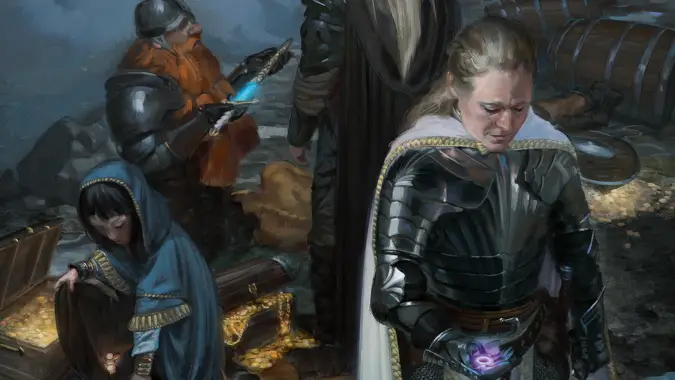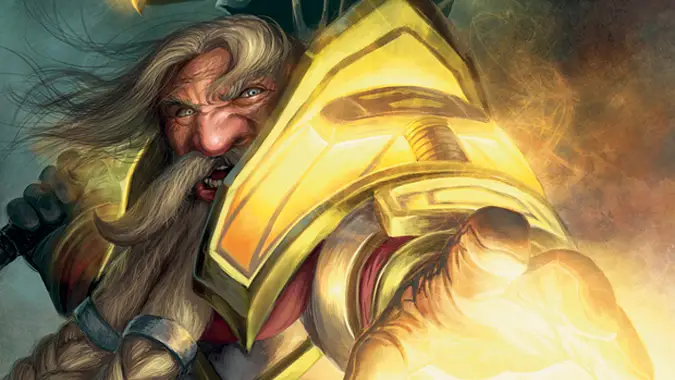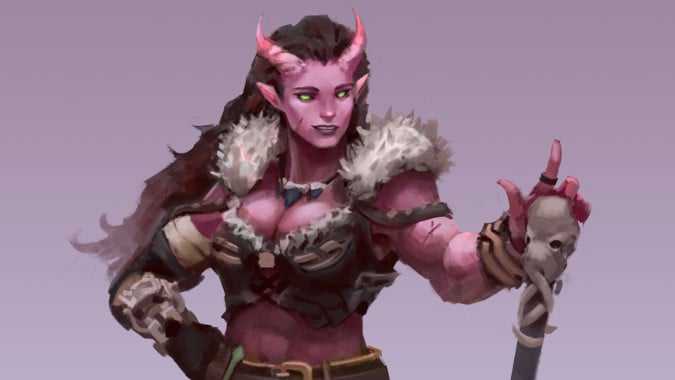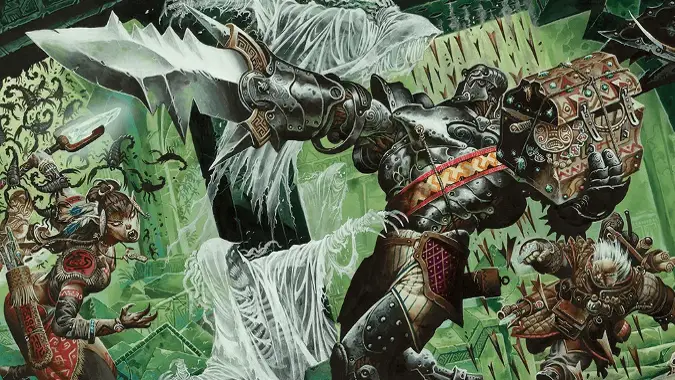D&D races 101: All your options from the Players’ Handbook, from Halflings to Half-Orcs

If you remember our Dungeons and Dragons Classes 101 roundup, we’re using the same format here for our overview of the various races one can play. Things we will not be doing include going over the history of each class, so there won’t be yet another paragraph of me going originally, Elves and Dwarves and Halflings were classes you could play, not races at all because we’ve all heard Grandpa Rossi sit in his rocking chair and go on and on about the old days of box sets and hex maps.
This is an overview of the racial options in the 5th Edition Player’s Handbook and yes, this leaves out some of your favorites. It leaves out my favorites, too — no Aasimar, no Warforged, no Goliaths or Genasi. Those races are awesome and they add a lot of fun and flavor to D&D, but we’re already looking at nine options just in the Handbook. I recommend you check out books like the Elemental Evil Player’s Companion and Volo’s Guide to Monsters to really broaden out your selection of playable races.

Races are here to give options, not take them away
A lot of people reading this will come to Dungeons and Dragons from the video games it helped to inspire, like World of Warcraft. In WoW, races exist to help make things simpler for you — if you want to play a Night Elf, you can only play so many of the game’s classes. This is a holdover from the old days of tabletop RPGs, when playing as a Halfling meant you were a Thief and that was that. Nowadays, there are no racial based class restrictions in D&D. People may look askance at your Tiefling Paladin or say your Half-Orc Bard is playing against type, but there’s nothing in the rules forbidding a Halfling Barbarian.
Each racial option generally brings a few mechanical advantages that may go better with some classes than others. For example, Tieflings make amazing Warlocks because they get a +2 bonus to Charisma. But that’s also good for Bards, Sorcerers and even Paladins, and it’s not like a +2 to Charisma is bad for anyone — even that raging Barbarian might need to talk someone around once in a while. So it’s less a restriction and more a gentle encouragement (which, admittedly, some min-maxers may well leap upon) that you can choose to go with or abandon as you see fit.

D&D’s 9 core races in brief
Again, these are just the 9 races that are in the Player’s Handbook. I vastly prefer Aasimar to Tieflings, for example, but Aasimar didn’t make the Handbook and Tieflings did.
Dragonborn
The game is named Dungeons and Dragons. Dragons are a big draw. Unfortunately, except for some pretty out there campaign concepts, you can’t play as a Dragon. You’d be ridiculously OP. But, if you really love Dragons, and you really want some of that flavor of playing a Dragon, the Dragonborn are here to bring you tantalizingly closer to that basic concept. Dragonborn are born with an innate connection to one of the various types of Dragons in the game. Whether you’re a Black Dragonborn spitting acid at your foes or a Red Dragonborn exhaling gouts of fire, all Dragonborn have a breath weapon similar to a Dragons and a resistance to that same kind of damage. Your Blue Dragonborn can breathe lightning and takes less damage from electricity. In addition to the benefits of your Draconic Ancestry, any Dragonborn gets a +2 to Strength and a +1 to Charisma, making them excellent Paladins and a solid choice for any Strength or Charisma based classes.
Dwarves
If you’ve read Tolkien, watched The Lord of the Rings or the Hobbit prequel movies, or pretty much consumed any fantasy derived from that source (or read any Norse Mythology, which is where Tolkien stole most of his stuff) you’ll know the basics of the Dwarves in D&D. They tend to live underground, mine and work materials like stone and metal ores, they’re shorter than humans but stout and physically powerful for that. Dwarves get a bonus to Constitution, they can see in the Dark (called Darkvision in D&D), and while they’re a little slower than other races they can wear the heaviest armor without it slowing them down further. There are two main types of Dwarves in most D&D games, the Hill Dwarves and the Mountain Dwarves. Hill Dwarves get a bonus to their Wisdom and extra hit points every level, making them even tougher, while Mountain Dwarves get a bonus to Strength. All Dwarves have a natural resistance to poison. Dwarves can be a lot of fun to play, especially if you go against type to some degree — my main PC is a Mountain Dwarf Barbarian and she’s been a lot of fun for me so far.
Elves
This is another from the ‘if you read Tolkien or any fantasy you probably know these guys‘ category. Elves in D&D are probably the most diverse group, with a host of distinct kinds of Elves you could play. Even just in the Player’s Handbook there are High Elves, Wood Elves and Drow or Dark Elves as playable options, and some campaigns broaden that out even further to Eladrin, Sun Elves, Moon Elves and other options. Still, all Elves are Elves — long pointy ears, oodles of magic, deceptively good at swordfighting and archery (even the ones who mostly cast spells or pray a lot), I feel comfortable in saying that if you’re reading this article you probably already have a handle on Elves. All of them get a +2 to Dexterity, Darkvision, automatic proficiency in the Perception skill, and they don’t actually need to sleep, just meditate (called Trance) for 4 hours a day to get the effects of a long rest. This also means they get resistance to any magic that would charm them and they’re immune to magical Sleep effects.
Gnomes
Gnomes are similar to but legally (and mythically) distinct from Halflings. They’re a short people (one of only two playable races that are classed as Small instead of Medium in the Handbook) and are intelligent and curious by nature. There are two subraces of Gnomes in the Handbook — the Deep Gnomes (also called Svirfneblin and yes, I had to look it up) and the Forest Gnomes. If you come from World of Warcraft, you may be expecting a lot more technology than most D&D campaigns use, but the general portrayal of Gnomes as fast talking, intelligent and somewhat manic isn’t too far from the mark. Either Gnome subrace gets a +2 to Intelligence, Small size, Darkvision, and are resistant to magic used against them getting Advantage on Int, Wis and Cha saving throws against magic. Choosing a Gnome subrace really helps make them distinct, as Svirfneblin and Forest Gnomes have different worldviews.
Half-Elves
You like Elves, but you don’t want to be too Elfy. Maybe you want to be a brooding, tortured loner divided forever between two worlds. Or you just want to add some of that Human adaptability to your Elven grace and poise, kind of like a Peanut Butter Cup but with Elves and Humans instead of Chocolate and Peanut Butter. Well, congratulations, because the Half-Elf is the racial option for you. Half-Elves look like, well, someone who combines Human and Elven ancestry, with slightly less pointed ears and a bit more of a Human’s stocky build — frankly, humans will sleep with anything. They get +2 to Charisma and can add +1 to 2 other stats of their choice (no, you can’t double up here, it’s +1 to 2, not +2 to 1) making them extremely adaptable to any situation. They get the Elven Darkvision and resistance to magic that would force them to be charmed, as well as immunity to magic that would make them sleep, and they get proficiency in any two skills of their choice representing their Human flexibility. You can decide what your Elf and Human ancestries are, for example you could be a Half-Drow or a Half-Wood Elf, it doesn’t matter mechanically but it can be cool for role playing.
Halflings
Okay, seriously, Halflings are Hobbits. There’s no point in pretending, this is the single most blatant Tolkien derived concept in all of D&D. Halflings are short (the only other Handbook race that is considered Small rather than Medium) ranging between 3 and 3 and a half feet tall on average. There are two subclasses, the Stout Halflings (think the Shire Hobbits from LoTR) and the Lightfoot Halflings. Lightfoots are basically just Stouts who took to legging it more when they got attention for nicking things. Either way, Halflings get a +2 to Dexterity, the Lucky feature which lets them reroll any 1 they roll on a d20 roll (but if they roll 1 again, even Lucky won’t save them, they have to take that second roll no matter what it is), and their bravery means they get advantage against any saving throws vs. being frightened.
Half-Orcs
Humans will sleep with anything. D&D has embraced this simple truth and used it to turn out not one, not two, but three playable race options in the Player’s Handbook alone. Half-Orcs are what you get when a Human and an Orc have children. Like Half-Elves, they have a mix of the strengths of their parent’s peoples. In the past, some D&D groups (okay, most of them) have been less than careful with the idea of Half-Orcs. Look, Orcs tend to be portrayed in most media as brutal, savage warmongers and their relations with Humans aren’t always… great. That can be a part of your Half-Orc’s origins, but that doesn’t have to be your story if you don’t want it to be. Your Half-Orc can just as easily be the result of a perfectly happy union if that’s where you want to take it. Half-Orcs are strong and hardy folk, with a +2 to Strength and a +1 to Constitution. They get Darkvision, Savage Attacks which allows them to add an additional die to a critical hit’s damage, and the Relentless Endurance ability which basically lets you say “No, I don’t” when you drop to 0 hit points, popping back up to 1 hit point instead once per long rest. Half-Orcs are ridiculously hard to kill.
Humans
Look, this one’s a stretch, but I want you to try and imagine playing as the same kind of people who exist right now, and have always existed throughout the history of the world you live on. Too much? Okay. Then instead imagine what you’d get if you squashed Elves and Orcs together, and the result is basically a Human. In Dungeons and Dragons, Humans are essentially the baseline or default option — they lack all the weird and cool stuff like Darkvision, magic resistance, fire breath or so on, but they gain a lot for that lack of cool. Humans get a +1 to every ability score, for a total of +6 to stats compared to the usual +2 or +3 most other races get. Or you can take the Variant Human option (talk to your DM) and instead get +1 to any 2 stats of your choice, an extra Feat, and an extra Skill Proficiency. Humans are kind of boring but they’re really easy to make work for any class concept.
Tieflings
The last of our trifecta of people who exist because Humans are a randy lot, Tieflings are descended from demons, devils and other evil extraplanar beings. Remember, this doesn’t mean the character has to be evil, just like you don’t have to be into bowling just because your mom really loves it. Tieflings aren’t always the result of a Human hooking up with something, they can be descended from other Tieflings or even just have the trait pop up in an otherwise Human family. People tend to treat Tieflings with suspicion, because they look like demons and devils. For you WoW players, think Draenei but with an edgier backstory. Tieflings tend to be smart and learn how to deal with people, giving them a +1 to Intelligence and a +2 to Charisma. They have Darkvision, resistance to Fire damage, and gain a few spells they can cast innately as they level up even if they’re playing a Fighter or Barbarian. There are also a host of variant Tieflings tied to specific Infernal Bloodlines or ancestries if you’re looking to get creative with it.

But wait, there’s more!
I’m not going to try and go into detail on every other option available to you in Dungeons and Dragons, but there are a lot of published sourcebooks with playable Race options. Just for an idea of what’s out there from Wizards of the Coast, you can find this list of options on D&D Beyond and it’s extensive. I personally love Genasi, Goliaths, Aasimar, Tabaxi, Warforged and Gith but that would put this article up to fifteen races and I couldn’t justify all the ones I’m leaving out.
Talk to your DM if you want to play any option not listen in this article, but in my opinion part of the fun of D&D is all the ways it can flex and bend that video games like World of Warcraft simply can’t match, so as a DM I tend to err on the side of letting people play a broad variety of options. Trust me, Genasi aren’t going to break your campaign.
And also remember that many races come with variant options or subraces like Wood and High Elves, Mountain and Hill Dwarves, Deep and Forest Gnomes, or what have you. These provide a bit of variation while also allowing you to customize your racial choice. Don’t ever view this as forcing you down a path — there’s nothing wrong with playing a Gnome Barbarian or a Half-Orc Life Cleric. There’s nothing in the rules preventing you from doing any weird idea you have, so embrace that freedom.
Please consider supporting our Patreon!
Join the Discussion
Blizzard Watch is a safe space for all readers. By leaving comments on this site you agree to follow our commenting and community guidelines.
 @MatthewWRossi
@MatthewWRossi



